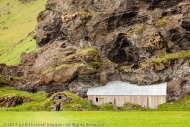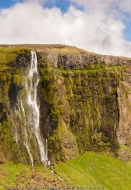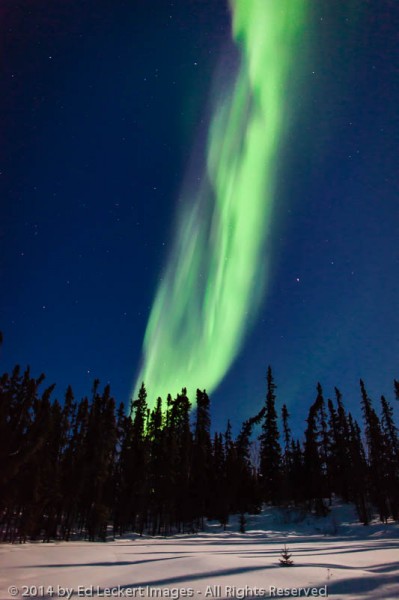


Just like Santa Claus and the Easter Bunny, as unlikely as it might seem at first, it really does exist after all! I’m talking about the aurora borealis. The Northern Lights. Those funny green (usually) lights that show up around the north magnetic pole. Don’t know about the aurora australis down south – haven’t seen those, yet. They may be a myth. I’ll have to check on that some other time. But here in the north, they’re real!
So as anyone who’s had to deal with me over the last couple of years knows all too well, I’ve been somewhat obsessed over seeing the Northern Lights lately. I don’t know what got me started – it was just one of those bucket list things that started to nag at me after a while. We had a rare opportunity to see them here in Seattle two summers ago, and wouldn’t you know I had a dinner date with my good friends Andrew and Kara who were leaving the next day after visiting from Connecticut. I knew the aurora was supposed to be really active that night and we might have clear skies, but, well, anyway. I saw some images a co-worker had taken in Mount Rainier National Park that night and nearly cried. And it takes a lot to make me cry – like a really good chick-flick. But I digress.
I had read several good books on the subject and had a pretty good idea of what causes them and how they look, but that’s not the same as actually experiencing the Northern Lights personally. So I signed up for aurora alerts with the Geophysical Institute at the University of Alaska Fairbanks and started monitoring the National Oceanic and Atmospheric Administration OVATION website. Those are both excellent resources if you find yourself obsessed about the Northern Lights as I was.
So what is the aurora and what causes it? Well, to put it in technical terms, our sun burps up solar wind in the form of ions flowing outward from it. The earth’s magnetosphere tries to protect us from the solar wind so that our electronics don’t get fried, but because of the way the magnetosphere is shaped (think iron filings around a bar magnet in science class, and then forget it, because it’s not exactly like that), it actually draws some of this energy toward the earth, somewhat in the shape of a crown over the magnetic poles. This energy comes shooting down into the atmosphere and gets oxygen, nitrogen, and all the atmospheric gases all excited, and they don’t like to get excited, so they spit out a photon and you have the Northern Lights. Or something like that.
OK, so I’m signed up for alerts. Now what? When an alert comes that predicts a great show, and I’m stuck in the Seattle area with all the light pollution here, and probably clouds as well, what am I going to do? Well, first I panic. Then I develop a plan. Mostly that planning involves looking at the local cloud cover forecast and trying to figure out how to sneak off to an area that looks dark and clear. This sort of process (panic followed by quick planning) can lead one to end up in unlikely places like Omak, Washington, as happened on one occasion last spring.
Optionally, one can simply plan to stay for a few days in a place known to have aurora sightings, like, I don’t know, Iceland. Then you just hope you’re there when the aurora does something interesting and you have a clear night if it does. That didn’t happen to me.
So finally I decided to go with a “sure bet”. I knew that if I went to Yellowknife in the Northwest Territories of Canada and stayed for a week, I’d have an excellent chance of seeing the aurora. They are directly under the auroral oval, the ring around the magnetic poles where an aurora is most likely to occur, and they are relatively dry as a result of being in the rain shadow of mountain ranges to the west. It was not yet so late in the year that the sky never gets dark, but it was late enough that it was no longer very cold at night, reaching only about -20°C at night. Yes, only. In mid-winter it could be -40°C at night, and that’s the difference between things working and things not working. Like cameras and cars.
Well, the sure bet payed off. There was only one night that I stayed out looking for the aurora and didn’t see much activity. Most nights it was so bright you could see it clearly even under the bright street lights of the city or under a full moon.
My plan, as I explained last week, had been to book an aurora hunting tour with a local guide service. My concerns were that I didn’t know the area, both from a safety standpoint as well as the best locations to see the aurora. Also, I didn’t want to get stranded out in the cold with a car that wouldn’t start.
Well, when I got settled and it looked like it would be a good night for aurora viewing, I called the guide service, and wouldn’t you know, they were full. And I had been worrying that they wouldn’t have enough people interested at this late in the season to meet their minimum.
Oh, well. I decided to take advantage of my B&B’s location and walk out the front door and onto the bay to get my shots that night. That’s right, the lakes around Yellowknife are still frozen so thick in April that cars can drive on them, so I walked out there after dark and started shooting. It wasn’t a great night after all, but I got some shots.
The next day I picked up my rental car, and after doing a good bit of research around town, I was ready to head out on my own. I now knew that -20°C is no big deal for cars in Yellowknife, I knew where the tour companies took their clients, and I knew what sort of wildlife was in the area in April (not much, it turns out). So that night I headed out Highway 4, known more commonly as the Ingraham Trail, a road made famous on the reality television series, Ice Road Truckers. I drove about 35 km to a place called Prelude Lake Territorial Park and started scouting around for good foregrounds to use in my images. I found a nice open meadow surrounded by evergreens right on the edge of the road with a nice view down to the frozen lake, and knew I had found what I was looking for.
It wasn’t even really dark yet when the show began. With a distinct glow still rising out of the west, and the nearly full moon appearing in the east, the lights of the aurora came on with a vengeance!
The full moon actually worked to my advantage, beautifully lighting the snow and forest foreground and adding visual appeal to the aurora images.

The aurora borealis appears to shoot out of the forest like a flame, on a moonlit night near Yellowknife, Northwest Territories, Canada.
Just as it was really getting dark, the tour group showed up with a van full of tourists. They headed down to the edge of the lake, and I smiled to myself, knowing I had found the place I wanted to be that night, and it was not where the tour would have put me.
After several hours of this, having used every foreground composition I thought would be interesting, I was finally starting to get pretty cold. I decided the show was going to outlast me, and hopped in the car and headed back to Yellowknife. For the entire trip I was surrounded by beautiful colors and shapes in the sky that were not the least bit discouraged by my headlights or the light of the moon. It was truly an amazing experience, and one that I will never forget.
But hey, if I ever do forget, I can always come back and read my blog!

Ed, I’m so glad you finally found the Northern Lights! The photos are beautiful! Thanks for sharing.:)
Me too, Sheela, me too! Now I can obsess over something else! 🙂
Very nice indeed. When I came to Seattle, I thought aurora borealis could be seen from Highway 99 (aka Aurora). 🙁
Actually, Abi, you may be somewhat correct.
“The segment north of downtown was officially named Aurora Avenue after the street that it follows in Fremont. Some say the name “Aurora” honored Aurora, Illinois, the hometown of Dr. Edward Kilbourne, a Fremont founder. However, George Cotterill, former city engineer, claimed that the name recognizes it as the highway to the north, toward the aurora borealis.”
http://www.lictonsprings.org/localin/aurora.html
Magnificent!!!!!!!
I would love to see the Northern Lights! Gorgeous photos, Ed! 🙂
So excited to see the images. The stories about your trip are great also.
As far as Aurora in Seattle I heard it was named after a woman who worked on Highway 99!
Way to go, Ed! Your explanation of the process that got you from “I want to…” to the images we see above is excellent and very encouraging to those of us who still have this on our Bucket List.